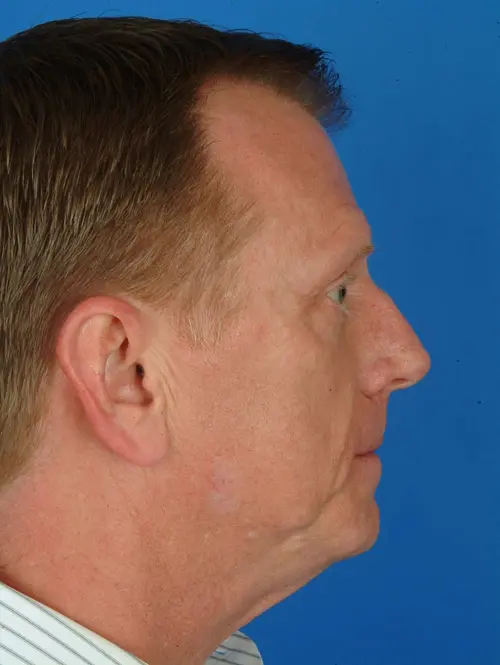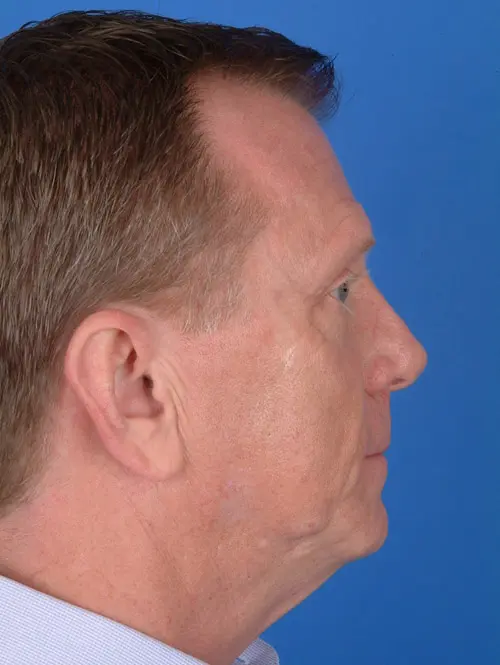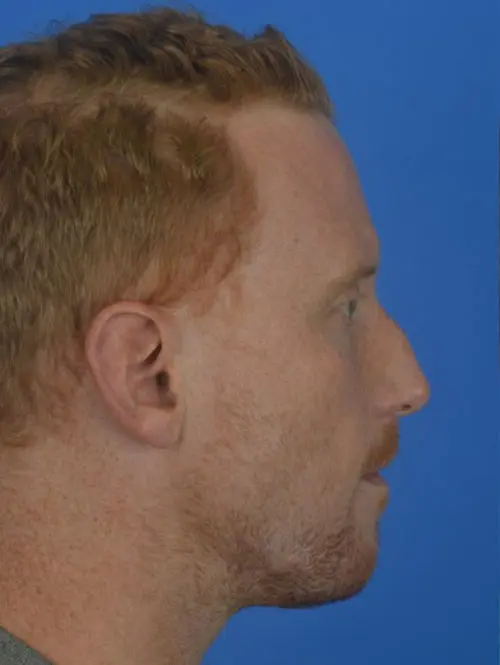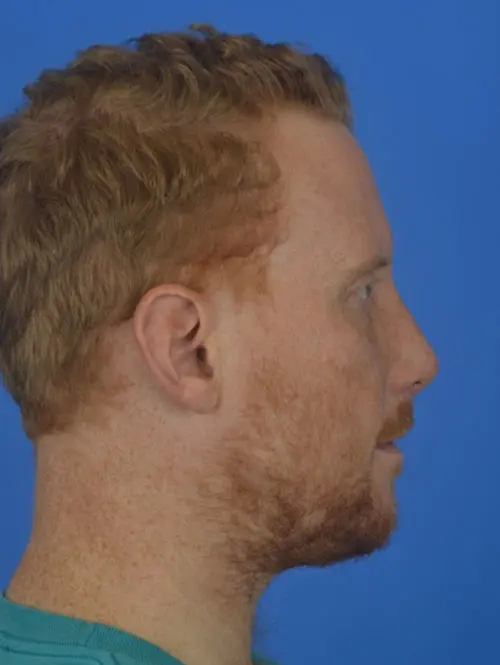 Model
Model
Septal Perforation Repair in Houston, TX
A nasal septal perforation is a hole in the septum, a dividing partition that separates the nasal cavity into two halves. This medical condition is quite complex and repair is extremely difficult technically with few surgeons who will perform this surgery. Triple board-certified, Dr. Russell Kridel is recognized by his peers as “The Expert” in Septal Perforation Repair. No other surgeon in the U.S. has the same level of expertise, experience, and publications in this specific surgery with a closure rate of 98% or better. Dr. Sean Delaney is trained in Dr. Kridel’s special technique of septal perforation repair and, along with Dr. Kridel, has published extensively in peer-reviewed journals on the subject.

 Model
Model
What Is A Septal Perforation?
A septal perforation is a medical condition where a “hole” exists in the nasal septum. If you have been told that you have a hole in your nose, you may wonder what that means. The nasal septum is the cartilage wall that separates the inside of your nose into two distinct sides or nostrils. When that wall has a perforation in it, the normal nasal air flow is disrupted and nasal bleeding, crusting and a feeling of breathing obstruction can occur. In some instances, the hole can get larger and the nose can collapse. The hole in a perforated septum is actually a hole in three layers, because the septal cartilage is covered on each side by a tissue layer of mucosa. To repair a perforated septum is extremely difficult and only an experienced septal perforation repair specialist should be the one operating on you for this condition.
Can a Septal Perforation Be Repaired?
The success of septal perforation repair surgery is directly related to the size of the perforation, the presence or absence of scarring, inflammation, and the surgeon’s experience.
Septal Perforation Repair surgery is considered one of the most difficult reconstructive nasal surgeries. Only a small number of surgeons in the United States perform this surgery and a rare few, like Dr. Russell Kridel has the depth of experience with such successful outcomes.
Why should I select Dr. Kridel for my Septal Perforation Repair?
Dr. Russell Kridel is triple-board certified and is internationally recognized by other physicians as the leading expert on Septal Perforation Repair. No other surgeon in practice today in the U.S. has the same level of expertise, experience and scientific publications in this specific surgery. He has published over 50 peer-reviewed journal articles and textbook chapters on Septal Perforation and has been the featured guest speaker on Septal Perforation Repair and Revision Rhinoplasty at hundreds of medical conferences around the world. Otolaryngologists and other Facial Plastic Surgery specialists commonly refer their perforation cases to Dr. Kridel. He has performed Septal Perforation Repair surgery for over 30 years with an overall closure rate of over 98% including the most complex cases. Over the past 6 years his closure rate is 99%. Dr. Kridel’s patients rave about the level of care they receive and how repair surgery with Dr. Kridel has improved their lives.

 Model
Model
What causes a Septal Perforation?
Having a septal perforation can be very traumatizing and can affect the quality of daily living. The most common causes of a septal perforation are from previous nasal surgery, nasal picking, or cocaine use. There are also less common causes from serious systemic diseases, which may be neoplastic, inflammatory, or infectious. Some steroid nasal sprays when used on a long-term basis can lead to perforation.
For more information, read our blog, Septal Perforation After Septoplasty.
What are symptoms of a Septal Perforation?
Common complaints with perforation are usually crusting, bleeding, and runny nose. If the perforation is small, patients may complain of nasal whistling. If the perforation is large, patients may complain of nasal obstruction. The further anterior the perforation the septum the more common for the patient to be symptomatic because this area of the nose is likely to be drier due to air flow. Sometimes if the perforation is small and posterior, no symptoms are present and the perforation may be found just on physical or endoscopic examination. Large perforations generally cause more symptoms of nasal obstruction because the hole disrupts the normal air flow.
How do our surgeons repair a Septal Perforation?
Dr. Kridel and Dr. Delaney believe it is important to repair the perforation to restore normal nasal function and physiology.
Surgical repair of a septal perforation is extremely complicated and requires operating within the narrow confines of the nose. Because a nasal septal perforation is a three-layered hole, all three tissue layers must be addressed and reconstructed during surgery. In addition, since many patients have a perforated septum as a result of a previous unsuccessful Rhinoplasty surgery, our surgeons frequently performs Revision Rhinoplasty surgery at the same time as the perforation repair. Success of the repair is based not only on the closure of the perforation, but also restoration of the physiological function of the nasal septum. In other words, our surgeons want to make sure the hole is closed, patients are symptom free, AND that normal breathing is restored. In general, techniques resulting in the highest success rate and best patient acceptance utilize extensively mobilized, bilateral, intransal mucosal advancement flaps and interposition and anchoring of a connective tissue graft.
Dr. Kridel, Dr. Delaney and the FPSA team are happy to provide copies of published medical journal articles he has authored that outline his surgical techniques in greater detail.

 Model
Model
What can I expect at my consultation?
Our Septal Perforation Repair consultations are very thorough. You can expect to be with us for two hours or so. When you first arrive, an FPSA team member will take your photograph and will also review your medical history and patient information forms with you.
Our surgeons will perform a complete examination of the inside of your nose as well as the outside. They will review your medical history and ask you to share your story about your perforation and any symptoms you may have. You will have the opportunity to share all your questions and concerns with your surgeon during your consultation. Dr. Kridel and Dr. Delaney will also ask you if there is anything you would like changed cosmetically to your nose as Rhinoplasty or Revision Rhinoplasty can be performed at the same time as the perforation repair if you desire.
We will also examine the inside of your nose with a Nasal Endoscopy at your visit. This test allows our surgeons to see the size and location of your perforation. As a result of the combination of the endoscopy and the nasal examination. Our physicians will provide you with an honest opinion if he believes he can successfully close your perforation with the understanding that there is no guarantee of a surgical outcome.
If you desire any cosmetic change to your nose, we will digitally morph your photos so that you can visualize the potential results from surgery. Dr. Kridel and Dr. Delaney will review the imaged photos with you to make sure that you share the same aesthetic vision. Of course, every person heals differently and there is no such thing as perfection, but our surgeons bring the imaged photos into surgery with they so that they can come as close as possible to your surgical goal. Very few plastic surgeons do this.
In addition, one of our patient concierges will accompany you every step of the way as your guide throughout your consultation. Your concierge will review before and after photos, provide educational materials specific to Septa Perforation Repair, and provide you with an estimate for your individualized treatment plan and also answer questions you may have prior to booking your surgery.

 Model
Model
Am I a good candidate for Septal Perforation Repair Surgery?
The best candidates for repair surgery understand that due to the complexity of septal repair surgery, there is no guarantee of closure and in rare instances with very large perforations, it may require more than one surgery. It is also important to devote the time needed for post-operative care and healing as well as a long-term healthy lifestyle. Patients with a history of cocaine and drug use must be completely drug free for at least a year before consideration for surgery. If there is any concern that future drug use is a possibility, the surgery should not be undertaken, as it is extremely likely that the perforation will re-occur. Our surgeons will also not operate on patients with a currently active history of nasal picking, smoking, vaping, or marijuana use, because these activities significantly compromise the healing process.
Can I combine Rhinoplasty with my Septal Perforation Repair?
Septal Perforation Repair patients often have cosmetic changes at the same time as the perforation repair so that there is just one recovery period.
Septal Perforation Repair is an out-patient procedure performed under general anesthesia at Hermann Surgery Center Kirby Glen and typically takes approximately 5.5 hours to complete. If Rhinoplasty or Revision Rhinoplasty is also performed, the surgery time will be longer. You should have nothing to eat or drink (not even water, candy, or gum) after midnight the night before your procedure. Patients should arrive approximately 1.5 hours prior to the start time on the day of surgery. You should wear a button-up top or loose-fitting clothing to allow you to change easily without placing unnecessary pressure or stress on the nasal area. You will need an adult driver on the day of your surgery to bring you to the surgery center and to take you home.
When is my pre-operative appointment?
Your pre-op appointment will take place two to three weeks before your surgery. We strive to make this appointment as stress free as possible. At this appointment, you will receive pre-operative and post-operative instructions, review and sign consents, take pre-operative photos, and make final payment. You will also receive the list of your prescriptions. Most of our patients find that using our Capsule Pharmacy service in advance is quite convenient because all prescriptions will be delivered to our office and ready for you at the pre-op appointment.
Dr. Kridel and Dr. Delaney believe that having healthier skin at the time of surgery will also help the healing process. Since you will have a splint on your nose for the first week, we provide patients with a complimentary nasal pore extraction treatment with our medical esthetician, Maria Alanis, at your pre-op appointment. No other plastic surgery practice in Houston provides this complimentary service. Patients also receive a kit with post-operative supplies and other helpful items. At this appointment, patients like to select skin care products appropriate for pre-operative and post-operative skin health and optimal healing.
Before Surgery
What do I need to do before surgery?
With any surgical procedure, it is necessary to avoid any medications or supplements that may thin the blood two weeks before and two weeks after your surgery. Our clinical staff will review instructions relating to medications and supplements at your pre-operative appointment.
Dr. Kridel and Dr. Delaney do not operate on patients who smoke, chew tobacco, vape or take illicit drugs prior to or at the time of surgery, as these activities have a detrimental effect to the healing process. Surgery can be cancelled if drug tests prior to surgery indicate usage.
We recommend that patients avoid alcohol for two weeks prior to and after your surgery. You should maintain a healthy diet and avoid salty, fatty foods and processed sugar. Some patients eat pineapple for the anti-inflammatory effect of its naturally occurring Bromelain. We recommend taking Arnica, Bromelain, and Vitamin C supplements 5 days before the surgery and 1 week following surgery. It is also very important to avoid significant sun exposure.

 Model
Model
Recovery Time
What can I expect right after Septal Perforation Repair surgery?
Dr. Kridel and Dr. Delaney do not pack your nose with uncomfortable Doyle splints. Instead, special soft material is placed inside your nose to hold the newly repositioned tissue in place. You will be seen the very next day in our office, and the material will be removed. You will need to sleep on your back with your head slightly elevated for the first several days to a week after surgery.
Our patients often comment that the discomfort is far less than they expected. Most patients feel very little pain immediately after surgery but may experience some discomfort later in the evening or the next day or so. We prescribe pain medications to help you feel more comfortable. However, we have found that most patients transition to Tylenol after a couple of days.
What is the recovery period for Septal Perforation Repair?
Our surgical techniques and pre-operative and post-operative care are designed to minimize bruising and help the healing process. Swelling will take place, along with some bruising, but the majority of bruising subsides within a few weeks. When your splint comes off after 5-7 days, you will see noticeable improvement if Rhinoplasty was also performed, but there will still be swelling. Breathing may still be restricted due to swelling of the repair and the silicone stents.
It takes approximately 4-6 months for about 80% of the swelling to go down. Your nose will continue to look better and better over the months to come until you see the final result “settle in” within a year or longer if Revision Rhinoplasty was also done.
Most patients feel like themselves after just a few days. As a general rule of thumb, patients can return to work after two weeks, after the splint and compression tape comes off.
Our surgeons and the FPSA Team will be with you every step of the way during your journey. We will see you multiple times over the first two weeks, and also at 1 month, 3 months, 6 months and 1 year. Our high standard of patient care, including follow-up care, is unparalleled in Houston.

 Model
Model
How do I find the best Septal Perforation Repair surgeon for me?
There are very few experts in the United States with the training and depth of experience specific to Septal Perforation Repair surgery necessary for best possible outcome. The more difficult the size and location of the perforation, the fewer the experts who can close it. It is important that you select a triple board-certified facial plastic surgery specialist who is familiar with the anatomy and has extensive training and experience specific to septal perforation repair. When you search for a surgeon, be sure to ask how many perforation repair surgeries they perform every year, as well as their success rate. Also ask if the surgeon has published any peer-reviewed medical journal articles or textbook chapters on their septal perforation repair techniques.
You will likely find in your research that all roads lead back to Dr. Russell Kridel. He is the leading expert in Septal Perforation Repair. One of the many reasons patients travel from all over the United States to have their repair surgery performed by him.
Does insurance cover surgery?
Most insurance companies do not cover septal perforation repair surgery, or if they do, it is for a small portion. At Facial Plastic Surgery Associates, we do not accept insurance. However, patients can file directly with their insurance provider. We can provide patients with appropriate information they may need to self-file. Note that Dr. Kridel and Dr. Delaney will be considered out-of-network providers.
What if I am coming from out of town or out of the country?
It is very common for patients to travel from out of town to have surgery at FPSA. For patients coming from out of the country, or out of the greater Houston area, we require you to stay in Houston for at least two weeks after surgery. Our physicians will also want to see you for follow up several times during the first year after surgery. Some patients can be followed by their local ENT or facial plastic surgery specialist. You will also need to arrive a few days prior to surgery for your pre-operative appointment. Follow up care following surgery is so important. We will be seeing you in our office the very next day after surgery and every few days during those initial two weeks after surgery. Along with our doctors and our FPSA team, you will also need to actively participate in your follow up care. In addition, our surgeons do not want you to fly for at least two weeks after surgery because of the changing cabin air pressure. Our patient concierge will help guide you through your entire journey. Rest assured that you will be in the best of hands with Dr Kridel, Dr. Delaney and the entire FPSA team.
We understand that Septal Perforation Repair Surgery is a significant financial and emotional commitment. To assist patients from out of town or out of the country who are considering Septal Perforation Repair surgery, but it is difficult to travel two separate times for the consultation and the surgery, we provide a service for Dr. Kridel and Dr. Delaney to review your records for surgical consideration. You will need to reach out to our patient concierge to coordinate sending the following information: a copy of a nasal endoscopy with pictures, any medical records relating to your perforation including tests (example: CT Scan), a copy of the operative report(s) if you had previous nasal surgery, your medical history, as well as a photo taken from a frontal view from the neck up and a profile view from the neck up. The copy of the nasal endoscopy with pictures is required because it will help our surgeons understand the size and location of your septal perforation. Our patient concierge will share this information with them to determine if they believes you are a good candidate for successful septal perforation repair surgery. If Dr. Kridel or Dr. Delaney believes you are a good candidate, you may go ahead and schedule a consultation and possibly surgery. If you also want Rhinoplasty or Revision Rhinoplasty to be performed at the same time as the Septal Perforation Repair, we will take your photos at the consultation in our office and computer image that photo to help you visualize the outcome of the cosmetic change. It is important to understand that there is no guarantee for closure of your perforation and that it is possible that our surgeons will determine at your consultation that you should not proceed with surgery.
Fully Accredited
On-Site Surgical Facility
Dr, Sean Delaney, Dr. Russell Kridel and Team FPSA provide patients with an exceptional surgical experience at our AAAHC accredited on-site operating facility. Our patients enjoy the comfort, ease and convenience of having surgical and medical aesthetic procedures in our beautiful practice environment. Facial Plastic Surgery Associates’ operating room has been certified by the Accreditation Association for Ambulatory Health Care (AAAHC). Accreditation by this highly regarded, independent organization ensures that our in-office operating room meets the highest quality of standards and safety. This accreditation is similar to the process completed for out-patient surgical facilities associated with hospital systems.
Schedule a Consultation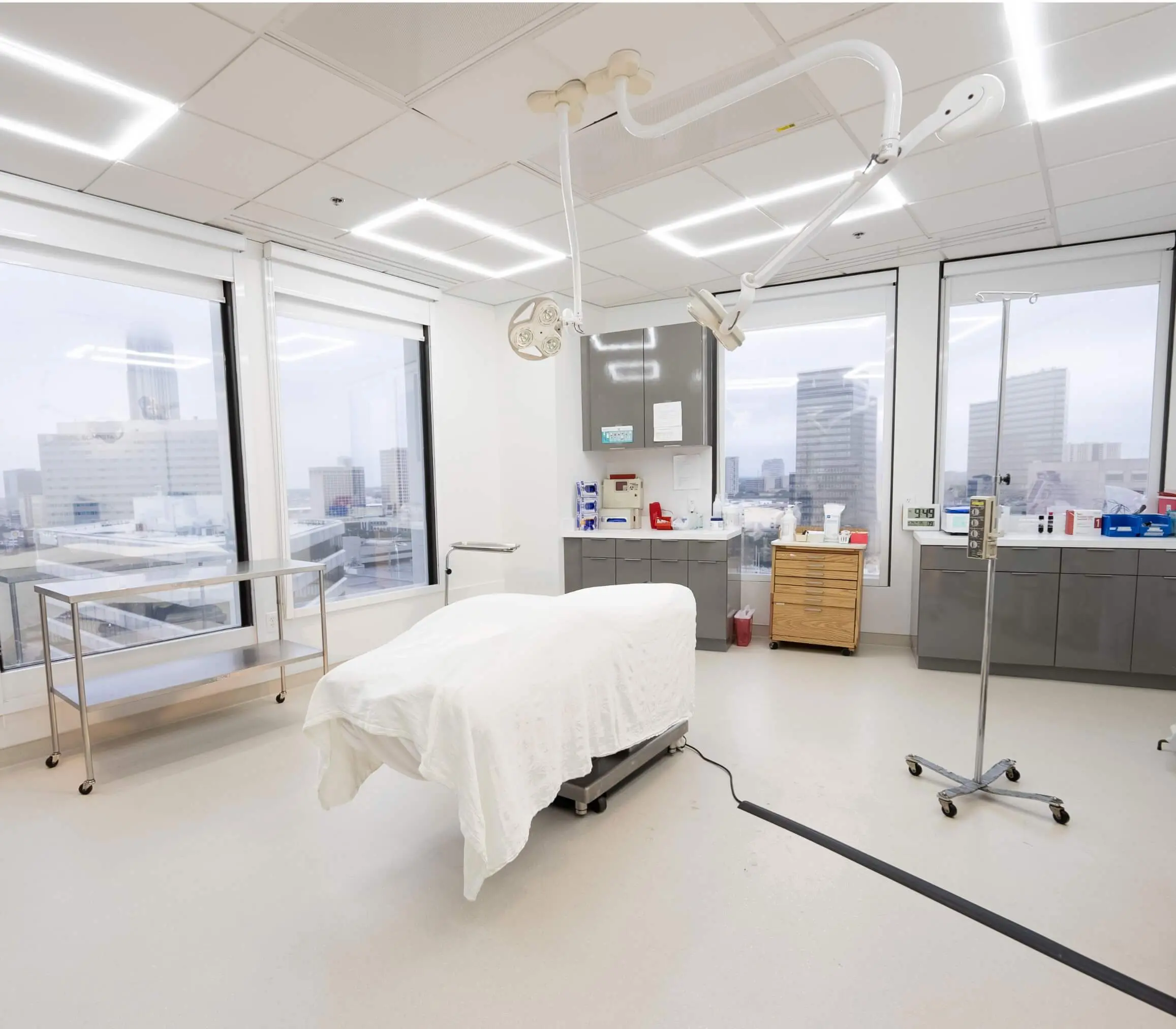

Let's Get Social
Connect with Us on Our Social Channels
Stay connected with us on social media and witness the impact Facial Plastic Surgery Associates has on the lives of our patients.




